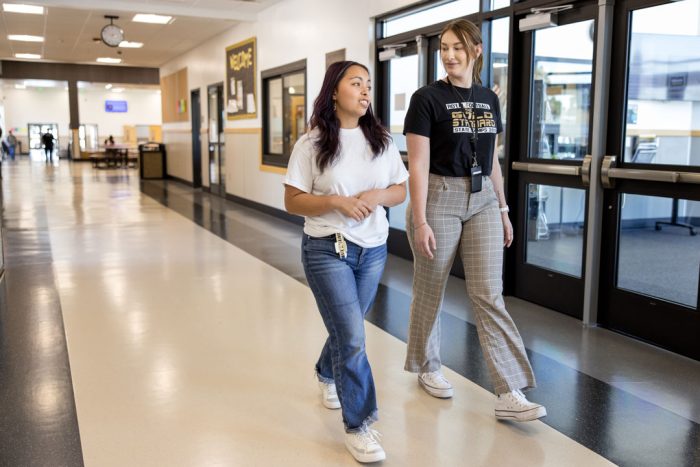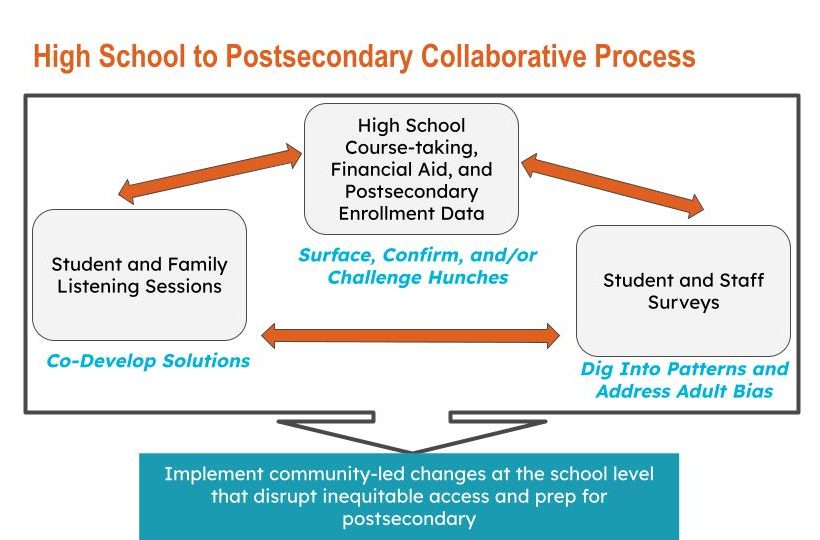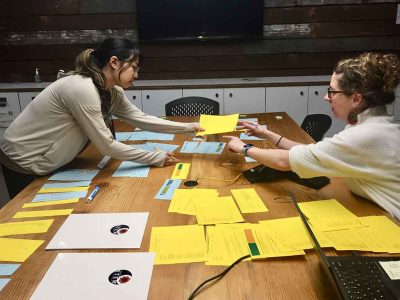H2P Collaborative: reimagining postsecondary pathways
By Joanne Walby.

“H-2-P” is one of the buzzwords you’ll hear around the offices of Washington STEM. It’s short for “High School to Postsecondary,” and refers to that exciting—and sometimes intimidating—transition between students’ K-12 education and the many pathways available to them after high school.
We focus on this transition because for almost half of Washington’s high school graduates, there is no formal postsecondary education. Only about 40% of high school students complete a degree/certificate/apprenticeship, leaving high-demand, household-sustaining wage opportunities on the table.
Over the past five years, our High School to Postsecondary Collaborative has evolved to work with schools and regional leaders across the state to improve postsecondary preparation so it is inclusive of aspirations, lights up possible pathways, and fosters a sense of belonging. This is done through a three-part process that starts with a review of course-taking data to understand patterns of which students take which courses, including dual credit, followed by the collection and analysis of student and staff surveys on their experiences in the preparation for postsecondary, and lastly, schools host listening sessions with students in order to co-design solutions.
With support and consultation from a key Washington STEM partner, Scholar Fund, high schools in the H2P Collaborative recently finished digging into the results from their student and staff surveys. After surveying 11,000 students–who largely mirror the demographics of the overall high school student population in Washington state, we found that the vast majority of students (86%) expect to pursue some form of education after high school.
The impetus for H2P started in 2019 when Washington STEM partnered with Yakima’s Eisenhower High School. A career counselor there had a hunch that dual credit enrollment was not equitable at this school where 60% of the population is Hispanic/Latino.
He was right: the data showed that fewer Hispanic/Latino students enrolled in dual credit programs than white students. The data also showed these students were more likely to be enrolled in career technical education courses, like auto mechanics.
Concurrently, research in South King County high schools by College and Career Leadership Institute (CCLI) found that despite low enrollment in postsecondary, the vast majority of students reported that they aspire to continue their education.
With support from College Spark Washington, Washington STEM designed the H2P Collaborative as a way to help more school teams, like those in Yakima and South King County, to uncover what was holding students back.
“The more we shared the results from Eisenhower High School, and connected with the CCLI work in South King County, the more we realized there was a huge demand for this kind of collaborative support. Educators wanted to better support students, but weren’t always sure where to start,” said Peterman.

Tana Peterman, K-12 STEM program officer at Washington STEM said, “We offer the student and staff surveys as part of H2P so schools can see data from their own school community to drive changes, and so we can keep an eye on trends across the state.”
She said the surveys allow school teams to test their hunches about student aspirations, knowledge, and experiences in preparing for postsecondary. Each school is provided with a results dashboard that allows them to disaggregate the data by grade and key demographics.
Uncovering the gap between student aspiration and educator knowledge
One persistent finding in the H2P surveys has been the gap between student aspirations and educator perception of student aspirations. In this latest survey, 86% of students report wanting to pursue some kind of education after high school. At the same time, educators in H2P schools reported that they believed only 72% of students have this aspiration to continue their education.

The first school to look at their postsecondary data was Eisenhower High School in Yakima five years ago. As their school leadership discovered, this gap is largely due to educators simply not having enough opportunities to deeply understand student aspirations, along with the up-to-date knowledge and resources to support students in their transitions out of high school.
“Educators’ plates are more than full with teaching content, addressing the long-term impact of the pandemic, and so on—so it’s not surprising to see the gap between student aspirations and what teachers know about those aspirations. The good news is, when educators see these data they want to work together to make changes in school culture and practices,” said Peterman.
Beliefs about the cost of college
Washington state ranked as #1 nationally when it comes to financial aid thanks in large part to the Washington College Grant which provides free tuition to low-income students and an increasing number of middle-income students. However, educators generally do not have access to contemporary financial aid knowledge and informational resources to be able to guide students in the right direction. Survey findings show that school staff reported believing that only 49% of students can afford to attend 4-year college using financial aid, scholarships, and family resources, while 68% of students believe in their ability to afford college with these same resources.

Chief Impact Officer, Jenée Myers Twitchell said, “These findings are significant because over the past two decades most efforts to improve high school to postsecondary outcomes had focused on direct student interventions—but H2P showed us that addressing “adult mindset and bias” of all school staff is crucial to creating programs that respond to student aspirations.”
Addressing adult mindset and bias
Ryan Beard, director of Career Technical Education (CTE) at Richland School District and member of the H2P Collaborative, said seeing survey results opened up a conversation and her district. Until then, many teachers did not think of postsecondary planning as part of their job.
She said when staff read the student survey responses, “It was eye-opening. It created motivation to change things. We had to ask, ‘Are we doing the best for our kids, if we aren’t even believing that they have these aspirations?’”

“Right now, teachers and counselors have separate jobs. The latter are overwhelmed — with 400:1 ratio in many schools, and teachers are under-equipped for the task of supporting students as they explore postsecondary pathways.”
-Ryan Beard, Director of Career Technical Education, Richland School District
Beard said as a result of the survey, her district is considering changes to the professional development calendar next year to include postsecondary planning. “Staff are starting to understand how getting trained on postsecondary options may improve the likelihood of kids continuing their education.”
Beard also pointed out that research has shown that the #1 factor impacting student achievement is Collective Teacher Efficacy–which is when teachers and staff have complete buy-in on their role supporting students.
“We all have to be rowing in the same direction,” Beard said, “Right now, teachers and counselors have separate jobs. The latter are overwhelmed–with 400:1 ratio in many schools, and teachers are under-equipped for the task of supporting students as they explore postsecondary pathways.”
Beard said this is not surprising because most classroom teachers (with CTE as a notable exception) spent their careers in school: going from K-12 to college then back to school. “So, while they can inform students about 4-year college, they often don’t understand the military, two-year programs or apprenticeships–which, granted, are complicated. It’s just a knowledge gap.”

Work sessions help troubleshoot access to data
After findings from the Eisenhower High School pilot study were released in 2021, Washington STEM expanded H2P into four new schools and based on what they learned through this process produced a step-by-step H2P Toolkit for other high schools.
Today, 40+ schools across the state are examining their postsecondary preparation processes and practices. The Collaborative’s member schools are setting up data dashboards, analyzing student and staff surveys, and hosting listening sessions with students. To support this work in schools, Washington STEM hosts monthly work sessions with regional leads, each coordinating H2P with between 2-9 schools in their region.
Peterman said these work sessions are part troubleshooting, part coaching, where regional coordinators develop practices for coaching school teams through surveys, listening sessions, accessing course-taking and enrollment data, and conducting root-cause analyses.
A key aspect of the project is helping districts understand how high school experiences–courses taken and specific program enrollment–correlate with enrollment, persistence, and completion of postsecondary programs.
A key aspect of the project is helping districts understand how high school experiences–courses taken and specific program enrollment correlate with enrollment, persistence, and completion of postsecondary programs. Washington STEM and regional leads provide technical assistance for schools to set up licenses for National Student Clearinghouse data, which tracks individual student enrollment in higher education. Teams also pull local data from their Student Information Systems (e.g., Skyward, Powerschool, etc.). Thanks to a partnership with Tacoma education non-profit Degrees of Change, districts have access to a data visualization platform that provides insights across the high school and postsecondary data.
Peterman said, “School and district leaders can already get a strong sense of their students’ postsecondary enrollment from the ERDC High School Student Outcomes dashboards. In H2P, we’re trying to take that one step further to help teams understand how the specific courses and programs that students take in high school relate to what they choose to pursue after high school.”
Navigating these detailed datasets has not been easy. Many school teams have run into barriers due to limited access to student data, data-sharing protocols, capacity to troubleshoot technical errors, and/or overall data literacy.
Although schools’ success in improving data access has varied depending on their technical capacity, many H2P partners today rely on data sets from NSC and the districts’ Student Information System to inform their decision-making. Washington STEM is working with partners across the state to explore a statewide system that alleviates the technical expertise required for schools and districts to access postsecondary data. In 2023 a new law was passed requiring school districts to notify student families about postsecondary data sharing between OSPI and higher education institutions in Washington. This data sharing will facilitate this kind of data transparency so all school districts can receive postsecondary outcomes data from the National Student Clearinghouse.

A need for statewide postsecondary supports
But there are also structural obstacles to seeing statewide improvements in direct postsecondary enrollment. Peterman pointed out that Washington has no single entity responsible for ensuring students experience a warm handoff between high school and their postsecondary pathway of choice. And although students are required to complete a High School and Beyond Plan, how robust this process is depends on a number of contextual factors. To make the process more equitable for students, OSPI has been working with partners across the state to design and implement an online statewide HSBP platform by late 2025 that has the potential to improve the systems that guide students from high school to their postsecondary aspirations.
At the Collaborative’s last work session in May, Peterman applauded the regional leaders and educators who continue to show up and dig in, keeping student experiences and outcomes at the forefront. “The work (collecting and reviewing data) is hard and frustrating—none of us have given up. We stick through the challenges and stay focused on improving our support for students. Folks are showing up and the impact in their regions, schools, and with students is real.”
***
Want to learn more? Check out the High School to Postsecondary toolkit.